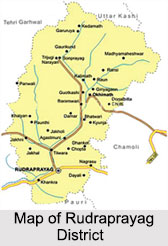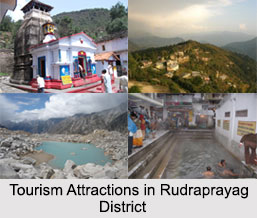 Rudraprayag District is an administrative district of the north Indian state, Uttarakhand. This district has its headquarters located at Rudraprayag. Rudraprayag District is blessed with immense natural beauty, places of religious importance, lakes and glaciers. Internationally known Shri Kedarnath Temple is at its north, Madmaheshwar temple at its east, Nagrasu at its southern east and Srinagar at its extreme south.
Rudraprayag District is an administrative district of the north Indian state, Uttarakhand. This district has its headquarters located at Rudraprayag. Rudraprayag District is blessed with immense natural beauty, places of religious importance, lakes and glaciers. Internationally known Shri Kedarnath Temple is at its north, Madmaheshwar temple at its east, Nagrasu at its southern east and Srinagar at its extreme south.
History of Rudraprayag District
Rudraprayag District was a part of Chamoli District and Tehri District. On 16th of September 1997, Rudraprayag District was carved out from whole of Augustmuni and Ukhimath block and part of Pokhri and Karnaprayag block from Chamoli, part of Jakholi and Kirtinagar block from Tehri Garhwal District, part of Khirsu block from Pauri Garhwal District.
Geography of Rudraprayag District
The total geographical area of Rudraprayag District is around 2328 sq kms. Mandakini River that originates from Kedarnath Peak is the main river of Rudraprayag District besides Alaknanda River. It originates at a height of 3641 metres below Balakun peak 16 kms upstream from Badrinath Peak. Most of the region of Rudraprayag District is mountainous. Most of the rivers in the district are snow fed and their water level is much below the land levels. Thus, the rivers of the region cannot be used for the purpose of irrigation. It is estimated that about nearly one-third of the worlds mountain species are found in the Himalayan region, which is mainly due to the diversity of the flora. Four fauna families, generally, abound in the Himalayan region are peninsular, the Indo-Chinese, paleo-arctic and the Tibetan. Rudraprayag District is rich in fauna and has been the habitant for very long time of large varieties of mammals, diverse species of birds, reptiles, insects and fish. Aquatic life in the district displays a mixed assemblage of wide variety of faunal and floral elements.
Climate of Rudraprayag District
The climate of Rudraprayag District varies as per the different elevations of the district. Mostly it is moderate. The maximum rainfall is received during June to September.
Demography of Rudraprayag District
According to the Population Census in the year 2011, Rudraprayag district has a population of 236,857. Rudraprayag District has a population density of 119 inhabitants per square kilometer.
Economy of Rudraprayag District
Rudraprayag District is fully dependent on tourism and temples. But, there are some secondary industries. Rudraprayag District is also rich with mineral resources. Here, the humidity is relatively high especially during the monsoon season. Asbestos, Soapstone, Copper, Iron, Gypsum, Lead, Slate, Building Stone, Sulphur, Antimony, Arsenic, Lignite or Brown Marble, Mica and silver are some of the useful minerals found in Rudraprayag District.
Culture of Rudraprayag District
The people of Rudraprayag District have successfully preserved their culture, folklore, folk songs and folk dances. Folk dances, a distinctive feature of the district and being seasonal, form an important part of the culture of Rudraprayag District. The Thadiya dance, which is accompanied by song, is performed on Vasant Panchami. Other folk dances are Jeetu Bhagdawal and Jagar or Ghariyali. These dances enact mythological stories and the participants dance to the tune of drums and other musical instruments. Another popular dance form performed during the fairs and accompanied by song is the Chanchari in which both men and women participate. Folk songs are usually traditional and are sung particularly by the women. During the month of Chaitra the women of the village gather at a central place and sing traditional songs which generally relate deeds of heroism, love and the hard life which they have to lead in the hills. In the district, fairs, festivals, religious and social gatherings are the main occasions for recreation and amusement. On special occasions people arrange `Swangs` (open air dramatic performances) particularly depicting scenes or legends associated with Lord Shiva and Parvati. Many fairs are held in the district; some of the important ones are `Bishwat Sankranti`, `Gaucher Mela`, Nautha at Adbadri, Naumi at Hariyali, Nanda Devi at Bedni, Dattatreya Pooranmasi at Ansuya temple, Nagnath at Dewar Walla. Ramnavami, Nag Panchami, Raksha Bandhan, Janmashtami, Dussehra, Diwali, Makar Sankranti, Shivaratri and Holi are some of the major festivals celebrated in the district. Festivals play an important role in the life of people in the district, as elsewhere, and are spread over the entire year.
Tourism in Rudraprayag District
Rudraprayag District is known for its several temples and other popular tourist sites. This district is one of the main pilgrimage centers attracting a huge number of devotees from several parts of the country. Several legends are associated with Rudraprayag District and the travellers can have a glimpse of that by visiting its various temples. Rudraprayag, Augustmuni, Guptkashi, Jakholi, Sonprayag, Khirsu, Gaurikund, Deoria Tal, Chopta, Ukhimath, Gandhi Sarovar and Vasuki Tal are some of the main attractions of Rudraprayag District. The region also offers magnificent view of the snow clad mountains. Kedarnath Wildlife Sanctuary is another spot that is a must visit for the tourists.






